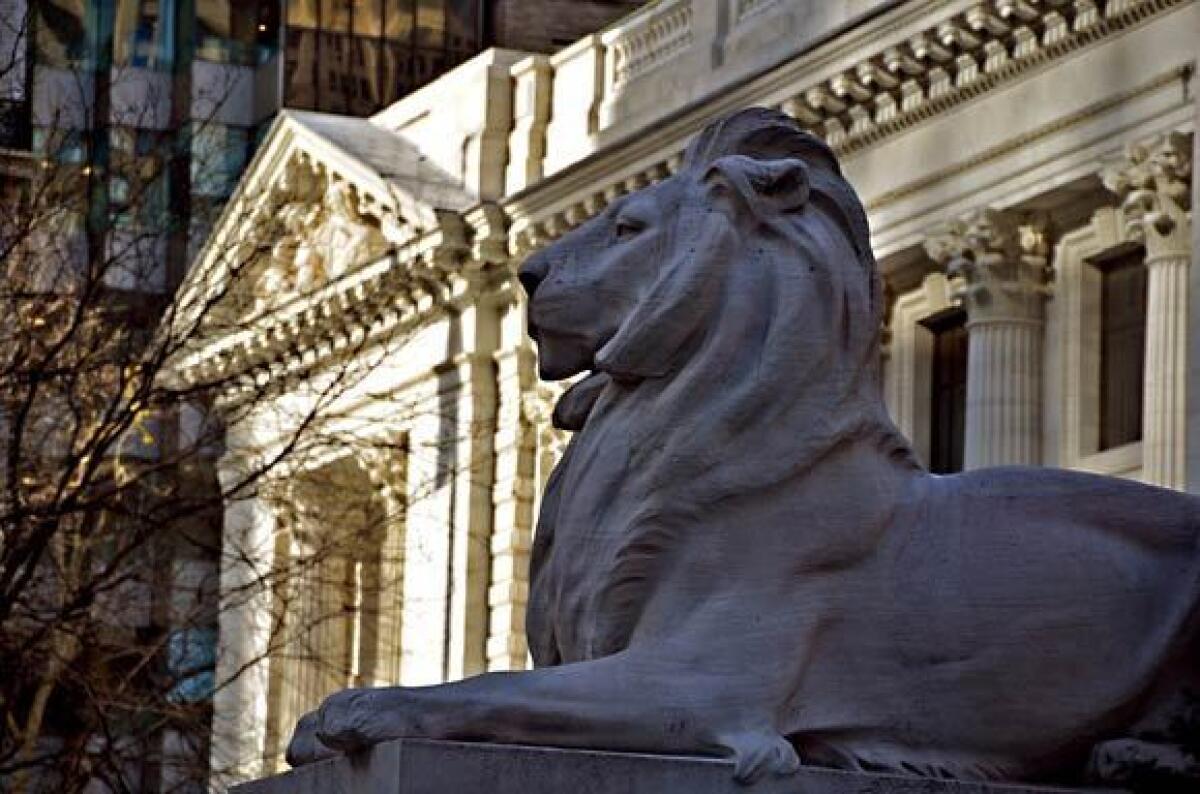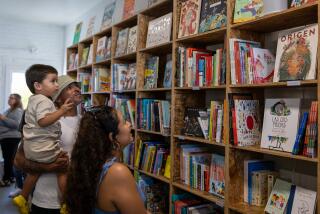New York Public Library gives up some of its secrets

- Share via
In my family, we’ve never recognized a distinction between happiness and the handling of books.
Books in libraries, books in shops. Books that take you places, and books you can steal from — like Norman Maclean’s memoir, “A River Runs Through It,” whose opening sentence (about religion and fly-fishing) has been ransacked for the benefit of that first paragraph.
My father, a journalist and professor, haunted bookstores, collected first editions and briefly ran his own tiny bookshop. For his 80th birthday, we made an after-hours appointment with one of his favorite booksellers — John Cole’s Book Shop in La Jolla — and cut loose on a family book-buying spree, sipping Champagne and chatting up the Coles between assaults on the shelves.
My mother studied library science at graduate school in Boston. About the time she met my dad, in New York in the early 1950s, she was working in a certain massive gray building at Fifth Avenue and 42nd Street — the New York Public Library’s main branch, in the old Central Circulation department. She always hoped to explore the building’s subterranean mysteries, she tells me, but could never get permission. She did, however, once check out a book to a tall, skinny man named Cornelius McGillicuddy — Connie Mack, who had just retired after 50 years as manager of the Philadelphia Athletics.
Nowadays my mother is a 91-year-old patron of the Pasadena Public Library. My dad is gone. John Cole’s is gone. But the NYPL and its Stephen A. Schwarzman Building endure, along with the highlights I hit on this recent literary tour of Manhattan.
And for some people — bibliophiles, history geeks, worshipers of all matters Manhattan — those greatest hits won’t be enough. So bear in mind, as you explore the library’s famous public rooms, what you can’t see.
Beyond closed doors, these librarians have stashed the archives of Vladimir Nabokov and Jack Kerouac; a first edition of Thomas More’s “Utopia” (1516); one of Virginia Woolf’s canes; Alice Liddell’s copy of Lewis Carroll’s “Alice’s Adventures in Wonderland” book, for which she was said to be the inspiration; and millions of books and other items — one of the world’s great humanities and social science collections and a central element in the city’s cultural character.
The library also caters to living writers in ways a tourist might not notice. On the second floor, behind closed doors, the library’s Cullman Center for Scholars & Writers since 1999 has offered yearlong fellowships to writers, including Ada Louise Huxtable, Ian Frazier, Edmund White and T.J. Stiles, whose biography of Cornelius Vanderbilt won a 2010 Pulitzer Prize. Since the 1950s, the library’s Frederick Lewis Allen Memorial Room has been reserved for writers with signed book contracts. This is where Robert A. Caro spent seven years researching “The Power Broker,” his Pulitzer-winning biography of Robert Moses.
There’s no doubt how much ownership New Yorkers feel of this building and its contents. In 2005, when the library sold a 19th century Asher B. Durand landscape painting called “Kindred Spirits” for an estimated $35 million or more to help pay for future acquisitions, many library patrons howled as if their own living rooms had been plundered. Maybe collecting art isn’t the library’s central mission, they argued, but that painting was an old friend, and the library’s Edna Barnes Salomon reading room wouldn’t be the same without it. (Nevertheless, the painting went. Look for it in Bentonville, Ark., when Wal-Mart heiress Alice Walton opens her Crystal Bridges Museum of American Art there in late 2011.)
The day I visited, curator David Wachtel was leading dozens of Jewish and Muslim fifth-graders through an exhibition (since closed) on Judaism, Christianity and Islam, and Astor Hall was filled with happy, boisterous kids in scarfs and skullcaps.
Upstairs in the Stokes Gallery, visitors browsed a series of boldly colored artworks from “Radioactive: Marie & Pierre Curie, a Tale of Love and Fallout,” a book project by artist and author Lauren Redniss, inspired by the library’s Curie materials.
As I chatted with Sumie Ota, the assistant chief librarian who oversees the catalog room, reading room and the rest of the General Research division, a nearby patron raised his head, scowled with disgust and gave us a classic “shhhhhhhhh.”
“Take it somewhere else,” he stage whispered.
Before I left, the staffers were kind enough to take me behind the scenes to check out my mother’s old territory, the former Central Circulation department.
They explained that because the central library building has grown into a center for research and exhibitions that doesn’t circulate books (except for the children’s department), what you read in the Schwarzman Building stays in the Schwarzman Building. That has freed up the old Central Circulation department for other uses.
The area’s main room, topped by a dome of cast-iron and glass and known as the Celeste Bartos Forum, is used for readings and other special events. Last October, for instance, one honored guest in that room was Keith Richards, the Rolling Stones guitarist and author of the 2010 memoir “Life.”
In many an anthology, Richards is credited with this observation: “When you are growing up there are two institutional places that affect you most powerfully: the church, which belongs to God, and the public library, which belongs to you. The public library is the great equalizer.”
It’s fun to picture that night: Patience and Fortitude at their posts outside, a crowd filling the seats, a shaggy, sneering, drug-tainted, propriety-flouting rock star standing center stage. This is not my mother’s public library, but I’m not complaining.
More to Read
Sign up for The Wild
We’ll help you find the best places to hike, bike and run, as well as the perfect silent spots for meditation and yoga.
You may occasionally receive promotional content from the Los Angeles Times.







